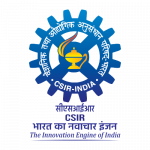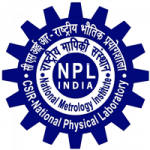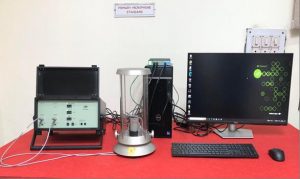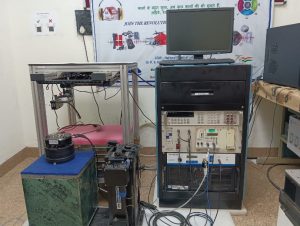
सीएसआईआर-राष्ट्रीय भौतिक प्रयोगशाला
CSIR-National Physical Laboratory

Acoustics & Vibration Metrology
CSIR-National Physical Laboratory has a strong base in R&D in the area of Acoustics and Vibration. The calibration and other facilities available in the area are comparable with facilities in other countries. CSIR-National Physical Laboratory, New Delhi, being the National Measurement Institute (NMI) of India, has the statutory obligation to establish, maintain and upgrade the national standards of measurement and calibration facilities for different parameters.
It is equipped with advanced instrumentation for measurement of sound and vibration and calibration of electro-acoustic equipments such as ‘Norsonic’ Sound Level Analyzer, ‘Pimento’ Vibration Analyzer, ‘Grass’ Sound Intensity Probe and specialized Reverberation and Anechoic Chambers for carrying out sound insulation and absorption studies of materials and diagnosing machinery noise. Apex level calibration and testing services and technical advisory consultancy in architectural acoustics are provided to the industry and institution of the country. R&D work is going on in applied acoustics and building acoustics.
The new facility of primary vibration calibration standard in extended frequency range of 0.1 Hz to 20 kHz had been established. The new microphone calibration standard facility using insert voltage technique was also established for the calibration of acoustic calibrators and microphones which has reduced the uncertainty in calibration to a level at par with other NMIs of APMP region.
CSIR-NPL maintains primary standards, viz. the standard of sound pressure, vibration amplitude and power. The primary standard of sound pressure (Fig. 1) is maintained through absolute calibration of standard condenser microphones in coupler cavity by the reciprocity technique in the frequency range 1 Hz to 25 kHz with an expanded uncertainty of ± 0.17 dB. The primary standard of vibration amplitude (Fig. 2) is maintained through absolute calibration of standard accelerometer by Laser interferometer technique in the frequency range 0.1 Hz to 20 kHz with accuracy better than ± 1.2 %. The accuracy of primary standards is verified periodically through participation in Key–comparison exercises with leading NMIs in the world.
The primary standard transducers are calibrated by absolute method while secondary and measurement transducers are calibrated by comparison and transfer standard method respectively. The latest international standard 16063-11 specifies three calibration methods based on laser interferometer viz., Fringe counting method (FCM), Minimum point method (MPM) and Sine approximation method (SAM). The FCM can be used for sensitivity calibration in the frequency 1 to 800 Hz. The MPM is intended for sensitivity calibration in the frequency range 800Hz to 10 kHz. The SAM covers the frequency range 1 Hz to 10 kHz and additionally makes it possible to measure the phase lag between the mechanical input and the accelerometer output voltage. The accuracy of transfer standards like sound level calibrator (± 0.15 dB) and vibration level calibrator (± 1.5 %) is determined with the help of transducers calibrated by absolute methods. The working standards like measurement microphones and accelerometers are calibrated with the help of transfer standards with an overall expanded uncertainty of ± 0.3 dB for microphones and ± 2.0 % for accelerometers. The field / in – situ measurements are carried out with the help of sound and vibration level meters which themselves are calibrated with the help of transfer standards (spot checking).
Technical services projects, Consultancy and external funded projects are also provided in the setting up of the acoustic facility, noise and vibration abatement, building acoustics, environmental noise and for particular NDT problems.

Fig. 1: Primary Microphone Calibration Standard using Reciprocity Technique

Fig. 2: Primary Vibration Calibration Standard using Laser Interferometer
A. Parameters Covered
- Sound Pressure
- Vibration Amplitude (Displacement, Velocity & Acceleration)
- Sound Power
- Sound Transmission Loss
- Sound Absorption Coefficient
B. Facilities Available in the Section (Items Calibrated)
Standards & Measurement Microphones, Sound Level Meters, Loudspeakers, Standard & Measurement Accelerometers, Vibration Meters, Sound Level calibrators, Reference Sound Sources, Sound Absorbing Material, Sound Insulation Material, Crackers Noise, Noise & Vibration Measurement and Analysis.
| Parameters Covered | Calibration/Testing Facilities available for | Range and uncertainty (Expanded) at k = 2 and 95% |
|---|---|---|
| Sound Pressure | Standard and Measurement Microphone, Sound Level Meter, Sound Level Calibrators, Pistonphone | 40-160 dB (20 Hz-25 kHz) ±0.05-0.17 dB |
| Vibrational amplitude (Displacement, Velocity, Acceleration) | Standard and Measurement Accelerometers, Vibration Meters, Accelerometer Calibrator | Displacement: 0.001 – 10 mm (5 Hz-100 kHz) Velocity: 0.01 – 1000 mm/s Acceleration: 0.10 – 1000 mm/s 2 ± 1.0 % |
| Sound Power | Reference Sound Sources, Miscellaneous Noise Sources | 40-160 dB (31.5 Hz – 20 kHz) ±1.0 dB | Sound Transmission Class (STC) | Sound Insulation Materials | ± 1.0 dB (100 Hz – 4 kHz) | Noise Reduction Coefficient (NRC) | Sound Absorbing Materials | ± 5% (100 Hz – 4 kHz) | Noise and Vibration Measurement & Analysis | Fire Crackers, Multipurpose Halls, Recording Theatres, Ground Vibrations, Machinery Noise | 40-160 dB(20 Hz – 25 kHz) ±1.0 dB | Impedance Tube | Sound Absorption properties of small acoustical samples | ± 6.5% (50 Hz to 6600 Hz) |
C. Standards Used
Primary Standards
- Primary standard of sound pressure is maintained through absolute calibration of LS1P & LS2P laboratory standard microphones in coupler cavity by Reciprocity Technique (IEC 61094 Part 2)
- Primary standard of vibration amplitude is maintained through absolute calibration of laboratory standard accelerometers by Laser Interferometric technique using sine approximation method (ISO 16063-Part 11)
- Transfer standards are used for calibration of secondary standards from Echelon II & III level Laboratories
D. Areas of Consultancy, Technical services and External Projects
Institutional Consultancy, Technical services and External projects offered in areas of Building Acoustics, Noise & Vibration Control, Environment Noise Pollution, Sound Reinforcement System Environmental Impact Assessment with respect to Noise & Air Pollution, Atmospheric Boundary Layer (ABL) Studies, SODAR design, fabrication, installation, operation & maintenance, Dispersion modelling etc.
CSIR-NPL can also help towards setting up Acoustic Calibration Laboratories, Anechoic & Reverberation Chambers, Formulation of equipment selection guidelines, Training in Acoustic Metrology etc.
Applied Acoustics & Vibration, Building Acoustics, Environmental Noise, Acoustical Materials and Atmospheric Boundary Layer (ABL).
Dr. Naveen Garg
Sr. Principal Scientist & Head
Acoustic and Vibration Metrology Section
Email: ngarg@nplindia.org
Phone: +91-11-45609386
All Rights Reserved - The Official Website of CSIR-National Physical Laboratory, CSIR, under Ministry of S & T, Govt. of India
Site Designed & Managed by Knowledge Resource Centre
CSIR-NPL, New Delhi
India